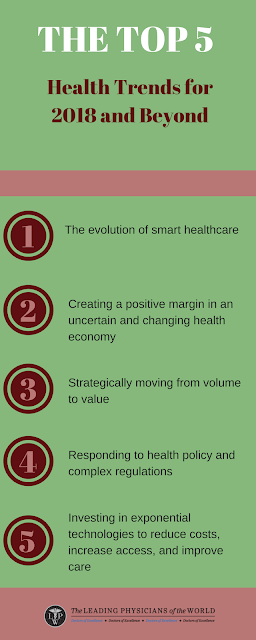Health Trends for 2018
To say that
2017 has been a tumultuous year for the healthcare industry is an
understatement. Federal policy changes and recent transactions involving large
insurers, health systems and retailers will affect providers, payers and
patients alike. Here are some of most emerging trends we need to pay close
attention to in 2018.
1.
Post-EHR
healthcare
The gravy
train of meaningful use (MU) is over. The effect of MU was a significant,
artificial, driver of adoption for a few EHRs. Today, digital health records
are the standard. As we move through 2018, keep an eye on EHRs and how they
justify their ROI once massive capital expenditures are written down. Likewise,
you’ll want to consider how clinicians adjust to this brave new world that we
live in.
2.
A New
Workforce
The new
business plan seems to be providing easy access to consumers by managing their
healthcare in one accessible place, whether it is a CVS, network clinic, or
surgical center. The necessity for primary care doctors are on the decrease,
which has been the case for years. Medical students are opting for the
higher salaried positions in more specialty medicine. The up-and-coming
profession of coaching has created personnel that can replace the time spent by
an MD with a patient who needs simple advice, screening, or education about
their condition and the medications prescribed. Health coaches are becoming
certified and gaining status in hospitals, clinics, and private practices.
Nurses are now becoming certified health coaches and will likely fill positions
in these retail health clinics.
3.
Social
Determinants Come to the Forefront
The US
spends more on healthcare than any other nation, but lags in outcomes. To
improve health while saving money, the industry needs to expand the borders of
healthcare. This means thinking beyond the four walls of the hospital and
looking at the full profile of a patient, beyond their specific health issue.
4.
The Real Cloud
HIMSS 2018,
the largest health technology conference on the planet, will for the first time
see booths of EHR vendors challenged by the equally massive booths of public
cloud service providers like Amazon, Microsoft, and Google. This is a
spectacular moment for healthcare, not just for the adoption of the real cloud
over simple virtualization, but also in the fragmentation of infrastructure and
services managed by third parties for healthcare delivery organizations.
5.
Price
Transparency Moves to the Statehouse
With no
clear legislative path for federal action on health reform, states are starting
to take matters into their own hands. Over 30 states are now considering
legislation that would directly control drug prices. It is important to watch
what happens at the state level, as past state healthcare reform efforts have
been brought to the national stage.
6.
Blockchain
to the Rescue
Blockchain
has made its way into healthcare. Smart contracts, immutability, and a clear
audit trail hold much promise for healthcare data and exchange. The problem is
that technology, especially when it comes to data sharing and interoperability
in healthcare, is not the dominant roadblock. Layering in new technology, like
blockchain, leaves the fundamental organizational and political problems
unsolved. Post-EHR healthcare is finally ready and incented to start making the
necessary changes that will align with the triple aim. Massive organizations
will vie for their place in this new healthcare world. Those who win will be
the providers and the patients.
7.
Medicare
Advantage swells in 2018
Medicare Advantage
is projected to cover nearly 21 million people in 2018, a 5% increase over
2017, providing a new competitive opportunity for health insurers. However,
many consumers don’t know these plans exist, so insurers must work to raise
awareness of options, and change those options to best meet patient needs.
Doctors,
hospitals and health companies now have insight into all
factors that can affect patient health, from lifestyle and income to genetics.
And they are using that information to connect people to a wide range of health
and social services within their communities. These healthcare trends will
certainly rule the healthcare industry in 2018.




Comments
Post a Comment